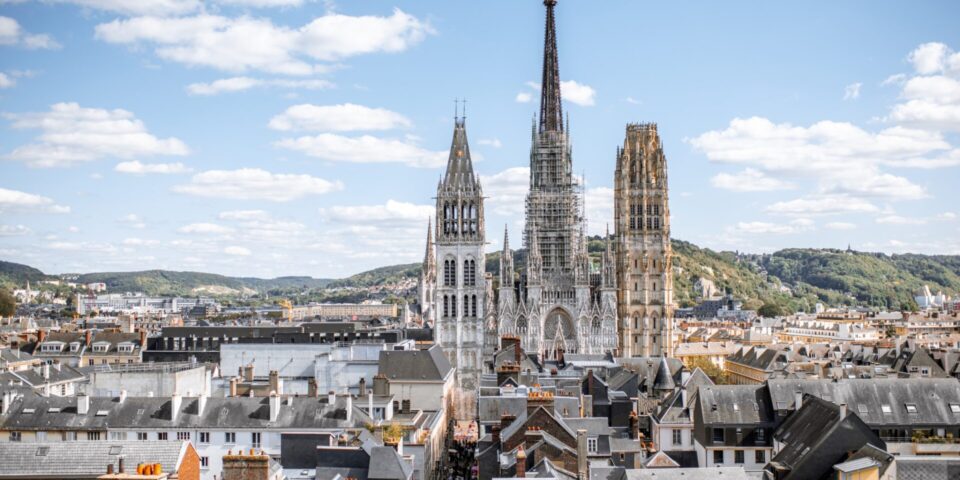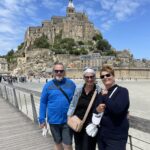- Cecyl Tarlier
- Normandie, Normandie, The best of France and its regions, Your guide: a committed professional
Rouen Normandy : The must sees
Rouen is a historic and culturally rich city located in the region of Normandy, France. It serves as the capital of the Seine-Maritime department and is situated on the banks of the Seine River. Rouen is often referred to as the “City of a Hundred Spires” due to its numerous churches and historic buildings that adorn the skyline.
Rouen France Normandy : The must sees
The Cathedral
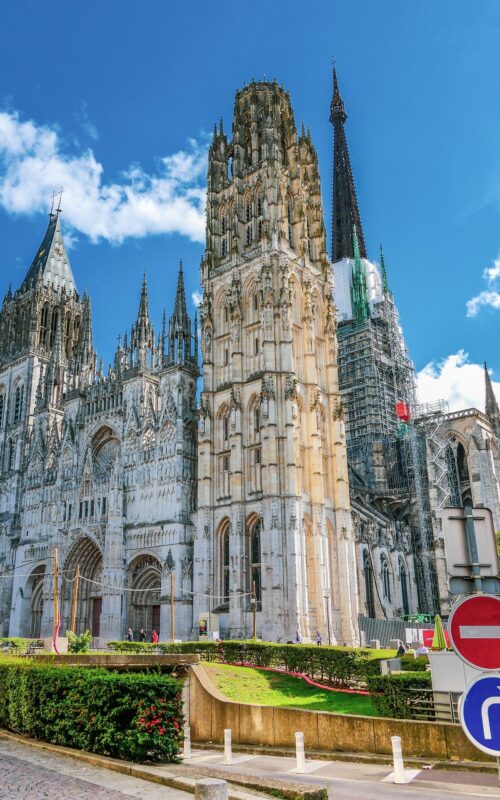
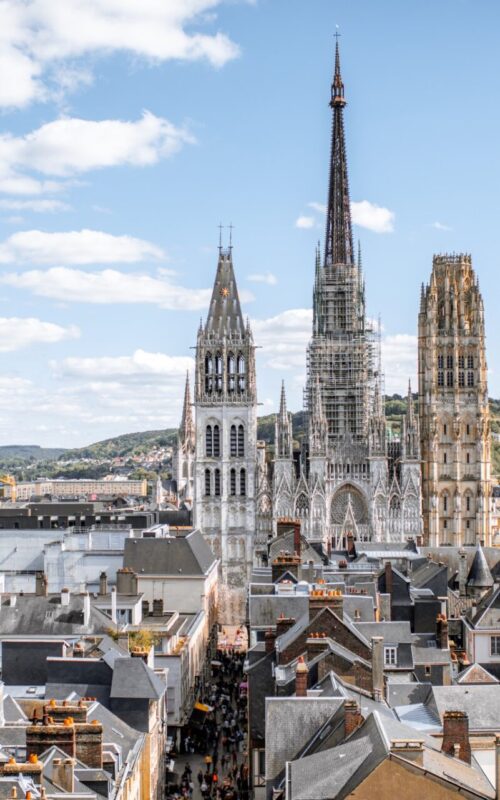
The Cathedral of Rouen, also known as Cathédrale Notre-Dame de Rouen (Cathedral of Our Lady of Rouen), is a stunning Gothic masterpiece located in the city of Rouen, Normandy, France. It is one of the most famous and historically significant cathedrals in France, renowned for its architectural beauty and artistic heritage.
Key features of the Cathedral of Rouen:
History: The cathedral’s construction began in the 12th century, around 1035, and it was completed in the 16th century. Over the centuries, it underwent several renovations and additions, reflecting different architectural styles, with Gothic being the predominant one.
Architecture: The cathedral is a prime example of French Gothic architecture. Its facade showcases intricate stone carvings, large rose windows, and statues of biblical figures and saints. The two towers, which were once surmounted by spires, rise prominently from the facade and dominate the city’s skyline.
Impressionist Connection: The Cathedral of Rouen gained further fame through the series of paintings done by the renowned Impressionist artist Claude Monet. He produced over 30 paintings of the cathedral, capturing its different aspects, lights, and moods at various times of the day and during different weather conditions.
Tombs and Chapels: Inside the cathedral, visitors can find numerous chapels, each richly adorned with religious art and sculptures. The cathedral also houses the tombs of several archbishops of Rouen and other notable figures from history.
The Butter Tower: One notable feature is the Butter Tower (Tour de Beurre), which was financed through the sale of indulgences to allow the consumption of butter during Lent, a time when it was traditionally forbidden.
Destruction and Restoration: Like many historical buildings, the Cathedral of Rouen suffered damage over the centuries. It was severely damaged by fire in 1200 and again in the 15th century. During World War II, it also sustained damage during bombings but was later restored.
The Cathedral of Rouen continues to be an important religious and cultural symbol for the people of Normandy. It attracts visitors from all over the world, drawn by its architectural grandeur, historical significance, and the artistic legacy left by Claude Monet’s famous paintings.
The Gros Horloge
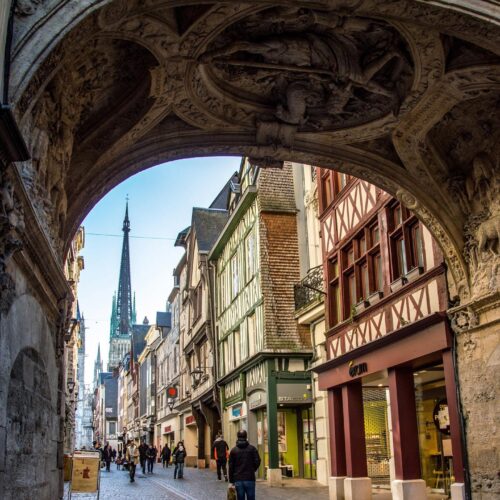
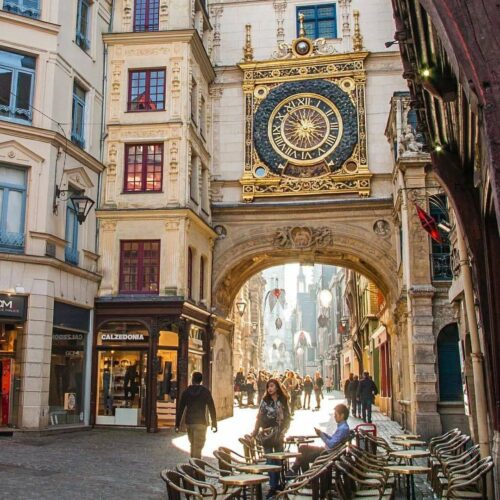
The Gros Horloge is another iconic landmark located in Rouen, France. It is a large astronomical clock and a historical symbol of the city. The name “Gros Horloge” translates to “Big Clock” in English. This monumental clock is one of the most famous and well-preserved examples of its kind in France.
Key features of the Gros Horloge:
History: The Gros Horloge dates back to the 14th century, with its construction starting in 1389. It was originally a simple astronomical clock with a mechanism to display the time, date, and lunar phase.
Unique Design: The Gros Horloge is housed in an elaborate Renaissance arch that spans the Rue du Gros Horloge, a prominent street in the heart of Rouen. The arch itself is adorned with intricate carvings and sculptures, showcasing the artistic and architectural prowess of the time.
Clock Mechanism: The clock features an impressive mechanism that includes various dials and gears to indicate the hours, minutes, days of the week, and phases of the moon. Visitors can see the inner workings of the clock through a transparent dial.
Bells: The Gros Horloge is accompanied by two bells: one for striking the hours and the other for chiming the quarters.
Symbolic Importance: The Gros Horloge has been a significant symbol of Rouen for centuries, representing the city’s heritage and historical legacy.
Museography and Access: Today, the Gros Horloge also houses a museum that allows visitors to explore the clock’s history and mechanisms in greater detail. You can climb the belfry to get a panoramic view of the city and experience the clock’s inner workings up close.
The Gros Horloge is a must-visit attraction for anyone traveling to Rouen. Its combination of architectural beauty, historical significance, and intricate clock mechanism makes it a captivating sight for tourists and a point of pride for the locals.
Discover the History District
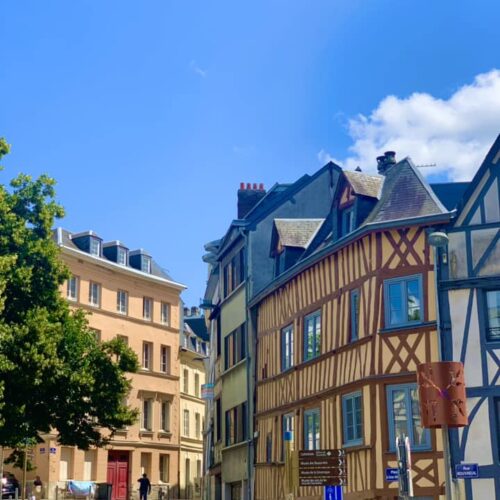
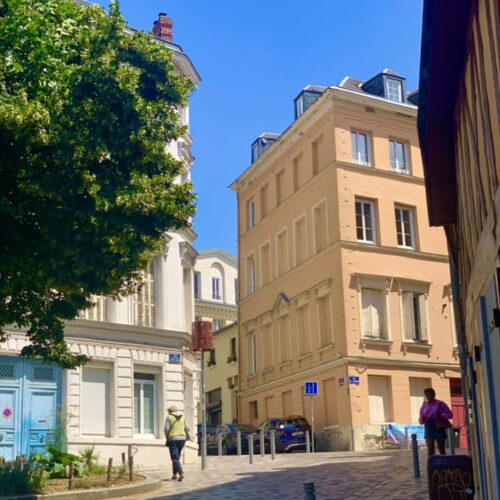
The history district in Rouen, also known as the Old Town or Vieux Rouen, is a charming and picturesque area that showcases the city’s rich historical heritage. Rouen’s history district is located in the heart of the city and is characterized by its narrow cobbled streets, half-timbered houses, and historic landmarks. This area is a testament to Rouen’s medieval past and has retained much of its original charm and character over the centuries.
Key features of the history district in Rouen:
Architecture: The history district is famous for its well-preserved medieval architecture. Many of the buildings feature half-timbered facades, which are a characteristic style of Normandy. These timber-framed houses with their colorful facades create a visually striking and enchanting atmosphere.
Rue du Gros Horloge: The history district is home to the Rue du Gros Horloge, the street where the Gros Horloge clock arch is located. This bustling street is lined with shops, cafes, and historic buildings, making it a popular spot for both tourists and locals.
Place du Vieux-Marché: This historic square is one of the most important in Rouen and holds significant historical significance. It was the site where Joan of Arc was famously executed in 1431. Today, the square is a lively hub with restaurants and shops.
Rouen Cathedral: While the Cathedral of Rouen is not technically part of the history district, it is located nearby and is an integral part of the city’s historical and architectural heritage. Its towering Gothic facade can be seen from many points in the Old Town, and it’s a must-visit site for its art, history, and connection to famous painters like Claude Monet.
The history district in Rouen is a captivating destination for history enthusiasts, architecture lovers, and anyone looking to immerse themselves in the medieval ambiance of this charming French city. Its well-preserved buildings, vibrant streets, and cultural attractions make it a delightful place to explore and experience the essence of Rouen’s past.
Rouen France : the church of Saint Joan of Arc
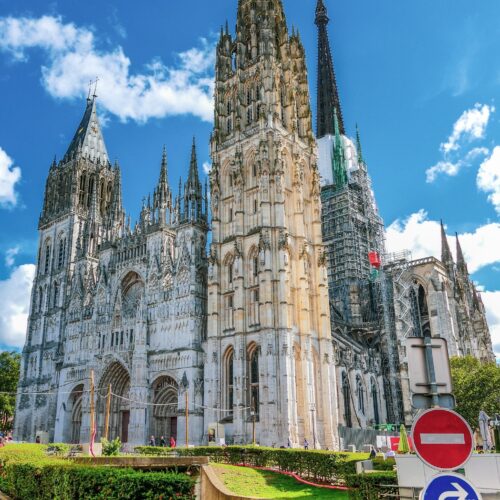
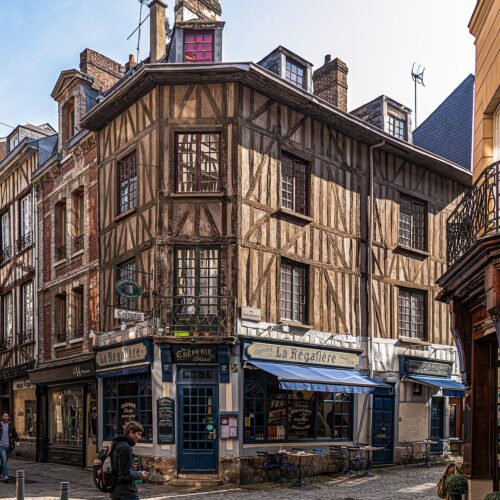
The Church of Saint Joan of Arc, also known as Église Sainte-Jeanne-d’Arc, is a modern architectural marvel located in Rouen, France. This unique church serves as a tribute to the city’s most famous historical figure, Joan of Arc, the young peasant girl who played a significant role in the Hundred Years’ War and was later canonized as a saint.
Key features of the Church of Saint Joan of Arc:
Architecture: The church’s design is contemporary and distinctive. It was completed in 1979 and is a creation of the architect Louis Arretche. The structure stands out for its modern aesthetic, with a cylindrical shape and a striking white concrete exterior.
Location: The Church of Saint Joan of Arc is situated in the Old Town of Rouen, close to the historical Place du Vieux-Marché, where Joan of Arc was famously executed.
Tribute to Joan of Arc: The church is dedicated to Saint Joan of Arc, whose statue can be found inside. The interior is designed to honor her memory and her heroic actions during the Hundred Years’ War.
Stained Glass Windows: One of the most remarkable features of the church is its stunning stained glass windows. These colorful windows depict scenes from Joan of Arc’s life and her martyrdom. The interplay of light through these windows creates a captivating ambiance inside the church.
Contemporary Design Elements: In addition to the modern architecture, the interior of the church also features contemporary artworks, adding to its artistic appeal.
Symbolism: The circular shape of the church represents unity and eternity, while the exterior’s whiteness is meant to evoke purity and spiritual significance.
Cultural and Spiritual Hub: The Church of Saint Joan of Arc serves as a cultural and spiritual center, hosting various events, concerts, and religious ceremonies. It attracts both tourists and locals interested in learning about Joan of Arc’s life and legacy.
The Church of Saint Joan of Arc is a significant landmark in Rouen, not only for its architectural design but also for the historical and spiritual importance it holds. It stands as a tribute to the courageous young woman who left an indelible mark on the history of France and the world.
Rouen France : Taste Local Products
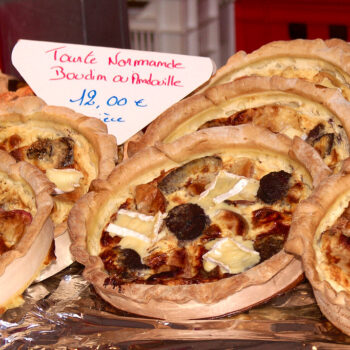
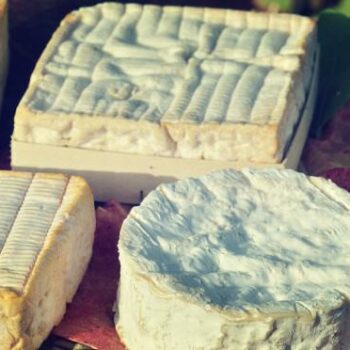
Rouen is a beautiful city in northern France with a rich history and a vibrant culture. The city offers a variety of local products that you can explore and enjoy. Here are some of the local products you might find in Rouen:
Calvados: Calvados is an apple brandy produced in the Normandy region, which includes Rouen. It’s made from cider apples and aged in oak barrels, resulting in a smooth and flavorful spirit. You can find various brands and vintages of Calvados in local liquor stores and specialty shops.
Camembert cheese: Camembert is one of the most famous French cheeses, and Normandy is its birthplace. Made from cow’s milk, it has a soft, creamy texture and a rich, earthy flavor. While you can find Camembert throughout France, trying it in Rouen will give you a taste of its authentic origins.
Cider: Normandy is renowned for its apple orchards, and the region produces excellent cider. It comes in various styles, from sweet to dry, and is a refreshing beverage to enjoy alongside your meals.
Neufchâtel cheese: Another cheese originating from Normandy, Neufchâtel is a soft, slightly crumbly cheese with a distinct heart shape. It has a mild and slightly nutty taste, making it a delightful addition to any cheese platter.
Pommeau: Pommeau is a delightful aperitif made by blending apple juice and Calvados. It’s a sweet and flavorful drink, perfect for sipping before a meal or as a dessert accompaniment.

